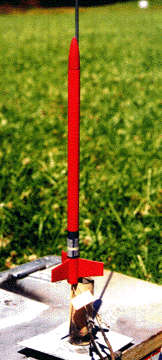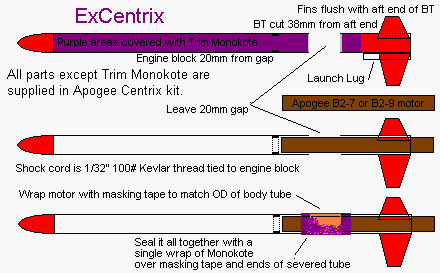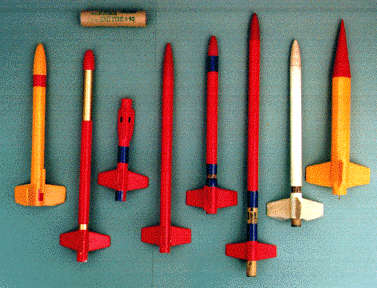 Brief: My Centrix kit and two A2-7 motors arrived a few days before Christmas 1998. (Having spent my rocket budget on HPR, I had ordered the minimum needed to get this thing in the air.) As soon as I had the kit out of the box I knew it was something very, very cool.
Brief: My Centrix kit and two A2-7 motors arrived a few days before Christmas 1998. (Having spent my rocket budget on HPR, I had ordered the minimum needed to get this thing in the air.) As soon as I had the kit out of the box I knew it was something very, very cool. 
Centrix is the most basic kit for Apogee's 10.5mm micro-motors and is optimized for their characteristics. It is extremely small, simple, and efficient in design. It took only an hour to build and, as advertised, could have been done easily by a beginner. Its fascination for an experienced rocketeer lies in its extremely small frontal area (therefore, small CdA), about one-fourth that of a BT-20 based model. It's only a little bigger than a ball-point pen and weighs under half an ounce with the A2-7 motor. This, with the long, low thrust curve of the micro-motors, results in out-of-sight, off-the-chart performance. The first flight, with an A2-7, was utterly out of sight on a hazy February day, but fortunately came down only about fifty feet from the pad.
One feature new to me was the Kevlar® shock cord. It's not stretchy, but doesn't need to be because the nose cone doesn't weigh much. Kevlar® is extremely tough stuff -- I had difficulty cutting it with my hobby knife.
My plan for the Centrix involves using it as a sustainer/dart on a high-powered booster. This project , called Hop on Pop, is months away, with several problems to solve; but honestly, the biggest problems stem from too much performance: How do you get the needed 17-second delay? How do you track something this size a mile and a half up? Will the Centrix's light construction hold up at Mach 0.8? And how about the stage coupler? We'll see...
Addendum April 18, 1999
A busy flightline and the process of certifying Level 1 limited me to two HPR and two model rocket flights April 17, but one of them was a Super Centrix attempt. The Apogee staging ignitor burned but the B2-9 didn't, and the Centrix clone arched over and did a lawn dart imitation. Fortunately, an unknown soul or souls retrieved both stages from the tall grass, and another attempt will be made. The upper section of the body tube was crumpled, but no other damage. It's been repaired already.
The A2-0 didn't really seem very impressive when lifting both stages. The day was pretty windy by then and it probably went 300 feet up. I look forward to seeing a good two-stage flight, and I'm tempted to start it with an A10-0 at some time.
Addendum April 30, 1999
Here's a variation on the Centrix intended to improve the coupling when/if I fly Hop on Pop.

Addendum, June 1999: At Millican on May 13, while we were setting up for a major launch the next day, several small rockets were launched and one of them was ExCentrix with a B2-9. This was approaching dusk, and the upward flight was spectacular but we lost all sight at apogee. The rocket was returned to me the next morning by another flyer who found it in the desert, about 200 yards downwind from the pad, deployed and in perfect condition.
The second weekend of June, I flew the thing into a clear blue sky with A2-7 (Picture,top right). This time the dense white smoke trail was impressive and sharply etched against the sky. I saw it the whole flight from launch to landing, which was about 150 feet downwind from the pad.
Note masking tape on body just above fins; that's all that holds it together. Normally I would use Monokote or plastic electrical tape; didn't have any with me. This particular flight used the short fin can intended for the A2, and the longer body section intended for the B2 flight.
Note also that the A2-7 motor is flush with the aft end of the body tube, not extended from it. The B motor is longer, so either the gap (pale stripe in this picture) will be longer, or the motor will extend from the back (good for staging), or both.
 Top: Estes 1/4A3-3T motor.
Top: Estes 1/4A3-3T motor.
Left to right:
"Spark" for Estes 1/4A3-3T (Flown at Millican, May 1999)
Centrix, stock from kit (flown on A2-7, Feb. 1999) The gold bands are Trim Monokote, as are the dark purple ones on the other models
Super Centrix booster stage (flown on A2-0 at Sheridan, April 1999)
Centrix clone, not yet flown
ExCentrix designed for A2-7 (used as upper stage in Sheridan flight; body tube has been replaced)
ExCentrix designed for B2-9 (flown at Millican, May 1999) (A2 fincan and B2 body flown June, 1999 on A2-7)
"Hop" ExCentrix designed for staging from a HPR booster, fiberglassed, not yet flown
"Red Hat," patched together piece of junk (but very sturdy) as practice for fiberglassing (Flown in my front yard with 1/4A3-3T July 4, 1999; none too stable; nose weighted and flown with A10-3T July 5)

 Brief: My Centrix kit and two A2-7 motors arrived a few days before Christmas 1998. (Having spent my rocket budget on HPR, I had ordered the minimum needed to get this thing in the air.) As soon as I had the kit out of the box I knew it was something very, very cool.
Brief: My Centrix kit and two A2-7 motors arrived a few days before Christmas 1998. (Having spent my rocket budget on HPR, I had ordered the minimum needed to get this thing in the air.) As soon as I had the kit out of the box I knew it was something very, very cool. 

 Top: Estes 1/4A3-3T motor.
Top: Estes 1/4A3-3T motor.



